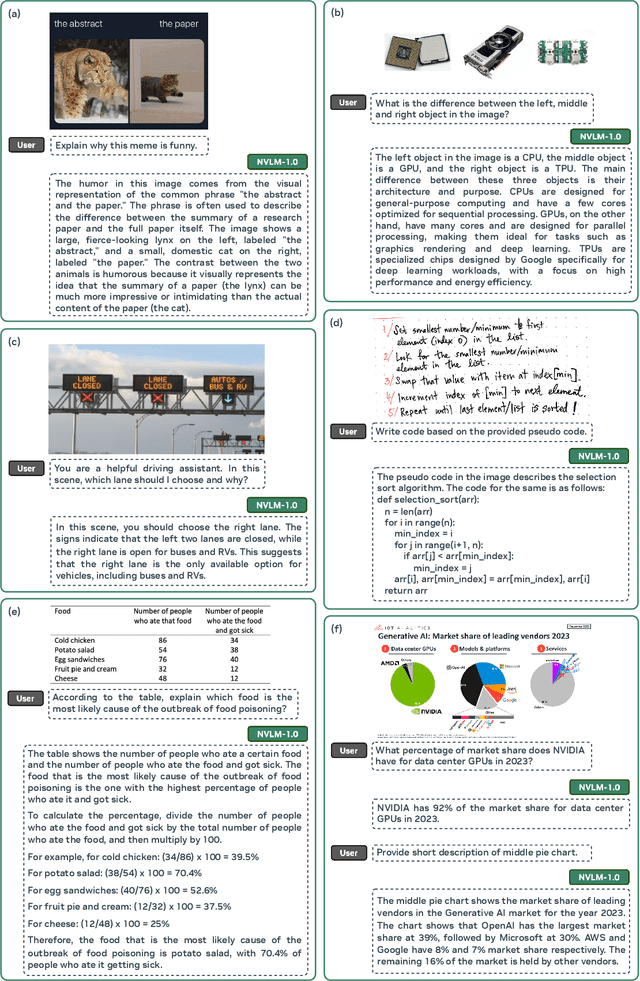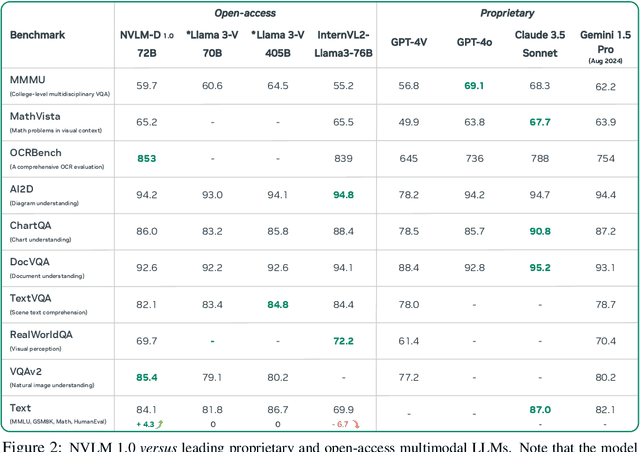Wenliang Dai
Nemotron-H: A Family of Accurate and Efficient Hybrid Mamba-Transformer Models
Apr 10, 2025Abstract:As inference-time scaling becomes critical for enhanced reasoning capabilities, it is increasingly becoming important to build models that are efficient to infer. We introduce Nemotron-H, a family of 8B and 56B/47B hybrid Mamba-Transformer models designed to reduce inference cost for a given accuracy level. To achieve this goal, we replace the majority of self-attention layers in the common Transformer model architecture with Mamba layers that perform constant computation and require constant memory per generated token. We show that Nemotron-H models offer either better or on-par accuracy compared to other similarly-sized state-of-the-art open-sourced Transformer models (e.g., Qwen-2.5-7B/72B and Llama-3.1-8B/70B), while being up to 3$\times$ faster at inference. To further increase inference speed and reduce the memory required at inference time, we created Nemotron-H-47B-Base from the 56B model using a new compression via pruning and distillation technique called MiniPuzzle. Nemotron-H-47B-Base achieves similar accuracy to the 56B model, but is 20% faster to infer. In addition, we introduce an FP8-based training recipe and show that it can achieve on par results with BF16-based training. This recipe is used to train the 56B model. All Nemotron-H models will be released, with support in Hugging Face, NeMo, and Megatron-LM.
NVLM: Open Frontier-Class Multimodal LLMs
Sep 17, 2024



Abstract:We introduce NVLM 1.0, a family of frontier-class multimodal large language models (LLMs) that achieve state-of-the-art results on vision-language tasks, rivaling the leading proprietary models (e.g., GPT-4o) and open-access models (e.g., Llama 3-V 405B and InternVL 2). Remarkably, NVLM 1.0 shows improved text-only performance over its LLM backbone after multimodal training. In terms of model design, we perform a comprehensive comparison between decoder-only multimodal LLMs (e.g., LLaVA) and cross-attention-based models (e.g., Flamingo). Based on the strengths and weaknesses of both approaches, we propose a novel architecture that enhances both training efficiency and multimodal reasoning capabilities. Furthermore, we introduce a 1-D tile-tagging design for tile-based dynamic high-resolution images, which significantly boosts performance on multimodal reasoning and OCR-related tasks. Regarding training data, we meticulously curate and provide detailed information on our multimodal pretraining and supervised fine-tuning datasets. Our findings indicate that dataset quality and task diversity are more important than scale, even during the pretraining phase, across all architectures. Notably, we develop production-grade multimodality for the NVLM-1.0 models, enabling them to excel in vision-language tasks while maintaining and even improving text-only performance compared to their LLM backbones. To achieve this, we craft and integrate a high-quality text-only dataset into multimodal training, alongside a substantial amount of multimodal math and reasoning data, leading to enhanced math and coding capabilities across modalities. To advance research in the field, we are releasing the model weights and will open-source the code for the community: https://nvlm-project.github.io/.
Negative Object Presence Evaluation (NOPE) to Measure Object Hallucination in Vision-Language Models
Oct 09, 2023Abstract:Object hallucination poses a significant challenge in vision-language (VL) models, often leading to the generation of nonsensical or unfaithful responses with non-existent objects. However, the absence of a general measurement for evaluating object hallucination in VL models has hindered our understanding and ability to mitigate this issue. In this work, we present NOPE (Negative Object Presence Evaluation), a novel benchmark designed to assess object hallucination in VL models through visual question answering (VQA). We propose a cost-effective and scalable approach utilizing large language models to generate 29.5k synthetic negative pronoun (NegP) data of high quality for NOPE. We extensively investigate the performance of 10 state-of-the-art VL models in discerning the non-existence of objects in visual questions, where the ground truth answers are denoted as NegP (e.g., "none"). Additionally, we evaluate their standard performance on visual questions on 9 other VQA datasets. Through our experiments, we demonstrate that no VL model is immune to the vulnerability of object hallucination, as all models achieve accuracy below 10\% on NegP. Furthermore, we uncover that lexically diverse visual questions, question types with large scopes, and scene-relevant objects capitalize the risk of object hallucination in VL models.
Survey of Social Bias in Vision-Language Models
Sep 24, 2023Abstract:In recent years, the rapid advancement of machine learning (ML) models, particularly transformer-based pre-trained models, has revolutionized Natural Language Processing (NLP) and Computer Vision (CV) fields. However, researchers have discovered that these models can inadvertently capture and reinforce social biases present in their training datasets, leading to potential social harms, such as uneven resource allocation and unfair representation of specific social groups. Addressing these biases and ensuring fairness in artificial intelligence (AI) systems has become a critical concern in the ML community. The recent introduction of pre-trained vision-and-language (VL) models in the emerging multimodal field demands attention to the potential social biases present in these models as well. Although VL models are susceptible to social bias, there is a limited understanding compared to the extensive discussions on bias in NLP and CV. This survey aims to provide researchers with a high-level insight into the similarities and differences of social bias studies in pre-trained models across NLP, CV, and VL. By examining these perspectives, the survey aims to offer valuable guidelines on how to approach and mitigate social bias in both unimodal and multimodal settings. The findings and recommendations presented here can benefit the ML community, fostering the development of fairer and non-biased AI models in various applications and research endeavors.
Visual Instruction Tuning with Polite Flamingo
Jul 03, 2023



Abstract:Recent research has demonstrated that the multi-task fine-tuning of multi-modal Large Language Models (LLMs) using an assortment of annotated downstream vision-language datasets significantly enhances their performance. Yet, during this process, a side effect, which we termed as the "multi-modal alignment tax", surfaces. This side effect negatively impacts the model's ability to format responses appropriately -- for instance, its "politeness" -- due to the overly succinct and unformatted nature of raw annotations, resulting in reduced human preference. In this paper, we introduce Polite Flamingo, a multi-modal response rewriter that transforms raw annotations into a more appealing, "polite" format. Polite Flamingo is trained to reconstruct high-quality responses from their automatically distorted counterparts and is subsequently applied to a vast array of vision-language datasets for response rewriting. After rigorous filtering, we generate the PF-1M dataset and further validate its value by fine-tuning a multi-modal LLM with it. Combined with novel methodologies including U-shaped multi-stage tuning and multi-turn augmentation, the resulting model, Clever Flamingo, demonstrates its advantages in both multi-modal understanding and response politeness according to automated and human evaluations.
InstructBLIP: Towards General-purpose Vision-Language Models with Instruction Tuning
May 11, 2023Abstract:General-purpose language models that can solve various language-domain tasks have emerged driven by the pre-training and instruction-tuning pipeline. However, building general-purpose vision-language models is challenging due to the increased task discrepancy introduced by the additional visual input. Although vision-language pre-training has been widely studied, vision-language instruction tuning remains relatively less explored. In this paper, we conduct a systematic and comprehensive study on vision-language instruction tuning based on the pre-trained BLIP-2 models. We gather a wide variety of 26 publicly available datasets, transform them into instruction tuning format and categorize them into two clusters for held-in instruction tuning and held-out zero-shot evaluation. Additionally, we introduce instruction-aware visual feature extraction, a crucial method that enables the model to extract informative features tailored to the given instruction. The resulting InstructBLIP models achieve state-of-the-art zero-shot performance across all 13 held-out datasets, substantially outperforming BLIP-2 and the larger Flamingo. Our models also lead to state-of-the-art performance when finetuned on individual downstream tasks (e.g., 90.7% accuracy on ScienceQA IMG). Furthermore, we qualitatively demonstrate the advantages of InstructBLIP over concurrent multimodal models. All InstructBLIP models have been open-sourced at https://github.com/salesforce/LAVIS/tree/main/projects/instructblip.
A Multitask, Multilingual, Multimodal Evaluation of ChatGPT on Reasoning, Hallucination, and Interactivity
Feb 28, 2023



Abstract:This paper proposes a framework for quantitatively evaluating interactive LLMs such as ChatGPT using publicly available data sets. We carry out an extensive technical evaluation of ChatGPT using 23 data sets covering 8 different common NLP application tasks. We evaluate the multitask, multilingual and multi-modal aspects of ChatGPT based on these data sets and a newly designed multimodal dataset. We find that ChatGPT outperforms LLMs with zero-shot learning on most tasks and even outperforms fine-tuned models on some tasks. We find that it is better at understanding non-Latin script languages than generating them. It is able to generate multimodal content from textual prompts, via an intermediate code generation step. Moreover, we find that ChatGPT is 63.41% accurate on average in 10 different reasoning categories under logical reasoning, non-textual reasoning, and commonsense reasoning, hence making it an unreliable reasoner. It is, for example, better at deductive than inductive reasoning. ChatGPT suffers from hallucination problems like other LLMs and it generates more extrinsic hallucinations from its parametric memory as it does not have access to an external knowledge base. Finally, the interactive feature of ChatGPT enables human collaboration with the underlying LLM to improve its performance, i.e, 8% ROUGE-1 on summarization and 2% ChrF++ on machine translation, in a multi-turn "prompt engineering" fashion. We also release codebase for evaluation set extraction.
NusaCrowd: Open Source Initiative for Indonesian NLP Resources
Dec 20, 2022Abstract:We present NusaCrowd, a collaborative initiative to collect and unite existing resources for Indonesian languages, including opening access to previously non-public resources. Through this initiative, we have has brought together 137 datasets and 117 standardized data loaders. The quality of the datasets has been assessed manually and automatically, and their effectiveness has been demonstrated in multiple experiments. NusaCrowd's data collection enables the creation of the first zero-shot benchmarks for natural language understanding and generation in Indonesian and its local languages. Furthermore, NusaCrowd brings the creation of the first multilingual automatic speech recognition benchmark in Indonesian and its local languages. Our work is intended to help advance natural language processing research in under-represented languages.
Plausible May Not Be Faithful: Probing Object Hallucination in Vision-Language Pre-training
Oct 14, 2022



Abstract:Large-scale vision-language pre-trained (VLP) models are prone to hallucinate non-existent visual objects when generating text based on visual information. In this paper, we exhaustively probe the object hallucination problem from three aspects. First, we examine various state-of-the-art VLP models, showing that models achieving better scores on standard metrics(e.g., BLEU-4, CIDEr) could hallucinate objects more frequently. Second, we investigate how different types of visual features in VLP influence hallucination, including region-based, grid-based, and patch-based. Surprisingly, we find that patch-based features perform the best and smaller patch resolution yields a non-trivial reduction in object hallucination. Third, we decouple various VLP objectives and demonstrate their effectiveness in alleviating object hallucination. Based on that, we propose a new pre-training loss, object masked language modeling, to further reduce object hallucination. We evaluate models on both COCO (in-domain) and NoCaps (out-of-domain) datasets with our improved CHAIR metric. Furthermore, we investigate the effects of various text decoding strategies and image augmentation methods on object hallucination.
Kaggle Competition: Cantonese Audio-Visual Speech Recognition for In-car Commands
Jul 06, 2022



Abstract:With the rise of deep learning and intelligent vehicles, the smart assistant has become an essential in-car component to facilitate driving and provide extra functionalities. In-car smart assistants should be able to process general as well as car-related commands and perform corresponding actions, which eases driving and improves safety. However, in this research field, most datasets are in major languages, such as English and Chinese. There is a huge data scarcity issue for low-resource languages, hindering the development of research and applications for broader communities. Therefore, it is crucial to have more benchmarks to raise awareness and motivate the research in low-resource languages. To mitigate this problem, we collect a new dataset, namely Cantonese In-car Audio-Visual Speech Recognition (CI-AVSR), for in-car speech recognition in the Cantonese language with video and audio data. Together with it, we propose Cantonese Audio-Visual Speech Recognition for In-car Commands as a new challenge for the community to tackle low-resource speech recognition under in-car scenarios.
 Add to Chrome
Add to Chrome Add to Firefox
Add to Firefox Add to Edge
Add to Edge